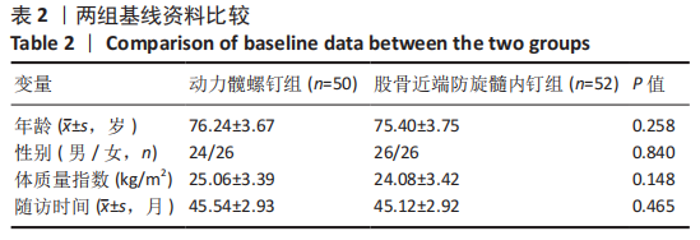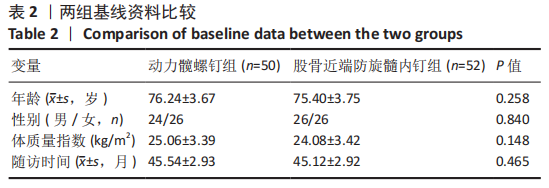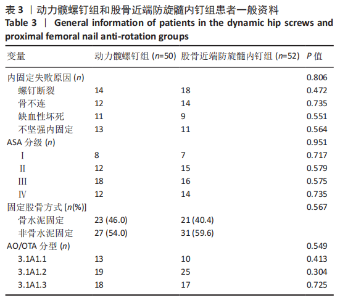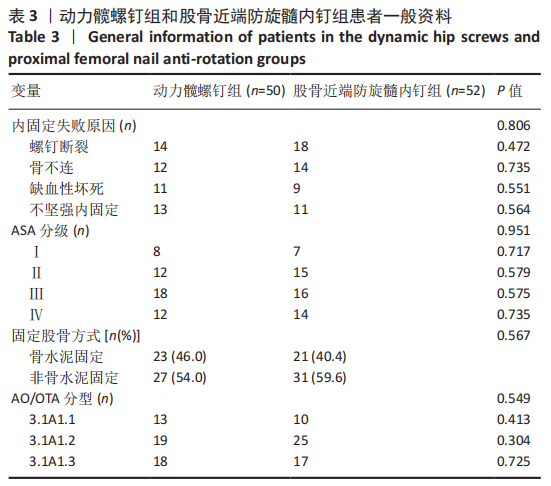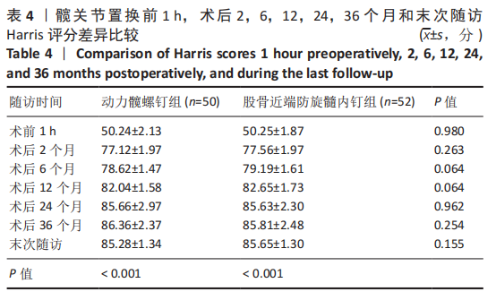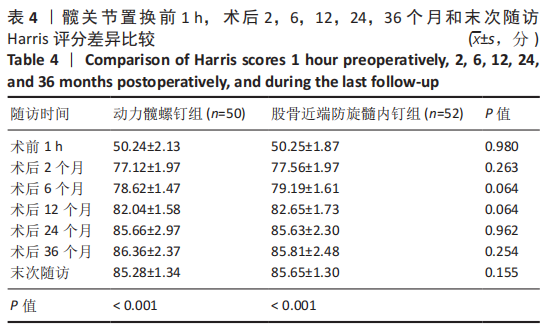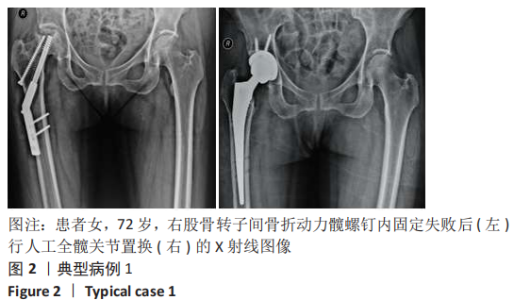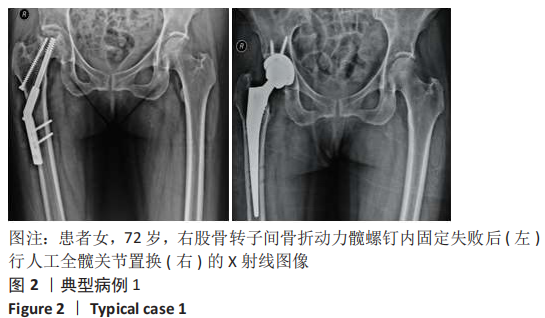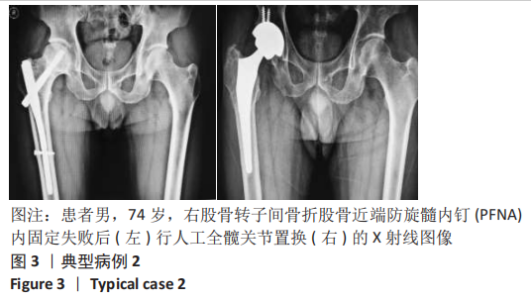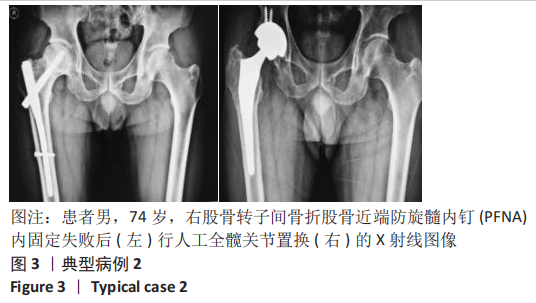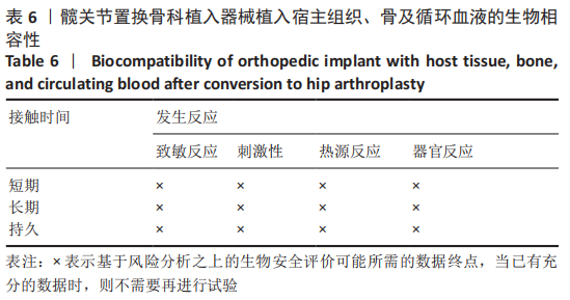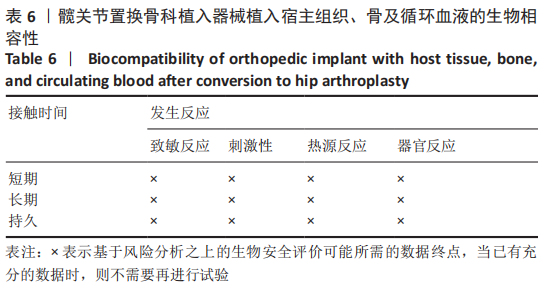Chinese Journal of Tissue Engineering Research ›› 2021, Vol. 25 ›› Issue (33): 5335-5340.doi: 10.12307/2021.323
Previous Articles Next Articles
Which is more suitable for conversion to hip arthroplasty after failure of dynamic hip screws or proximal femoral nail anti-rotation for stable intertrochanteric fractures in the elderly?
Zhang Tianyi1, Mao Kaige2, Dong Wei1, Li Lixin1, Kong Fanlin1, Zhu Jun1, Fan Guofeng1
- 1Department of Orthopedics, Hebei Petro China Center Hospital, Langfang 065000, Hebei Province, China; 2Dalian Medical University, Dalian 116044, Liaoning Province, China
-
Received:2021-01-28Revised:2021-01-30Accepted:2021-03-13Online:2021-11-28Published:2021-08-05 -
Contact:Fan Guofeng, Master’s supervisor, Chief physician, Department of Orthopedics, Hebei Petro China Center Hospital, Langfang 065000, Hebei Province, China -
About author:Zhang Tianyi, Master, Attending physician, Department of Orthopedics, Hebei Petro China Center Hospital, Langfang 065000, Hebei Province, China Mao Kaige, Master candidate, Dalian Medical University, Dalian 116044, Liaoning Province, China -
Supported by:the Project of Science and Technology Bureau of Langfang of Hebei Province, No. 2017013045 (to DW)
CLC Number:
Cite this article
Zhang Tianyi, Mao Kaige, Dong Wei, Li Lixin, Kong Fanlin, Zhu Jun, Fan Guofeng. Which is more suitable for conversion to hip arthroplasty after failure of dynamic hip screws or proximal femoral nail anti-rotation for stable intertrochanteric fractures in the elderly?[J]. Chinese Journal of Tissue Engineering Research, 2021, 25(33): 5335-5340.
share this article
Add to citation manager EndNote|Reference Manager|ProCite|BibTeX|RefWorks
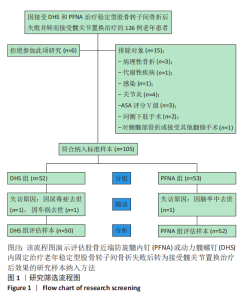
2.1 参与者数量分析 依据纳入标准纳入126例因接受动力髋螺钉或股骨近端防旋髓内钉治疗稳定型股骨转子间骨折后失败并转而接受髋关节置换治疗的老年患者,其中6例因个人原因中途退出此项研究,依据排除标准排除3例病理性骨折患者;1例因甲状腺功能减退致骨质疏松患者;1例内固定治疗后感染患者、4例合并骨性关节炎患者;3例ASA评分Ⅴ级患者(病危患者);2例同侧下肢曾接受其他手术者;1例对侧髋部骨折或接受其他关节翻修手术者。筛选出的105例患者中在随访过程中分别因尿毒症、车祸、心脏病失访3例。最终动力髋螺钉组和股骨近端防旋髓内钉组分别有50例及52例进入结果分析,此102例患者均得到了至少3年的随访。试验流程图见图1。"
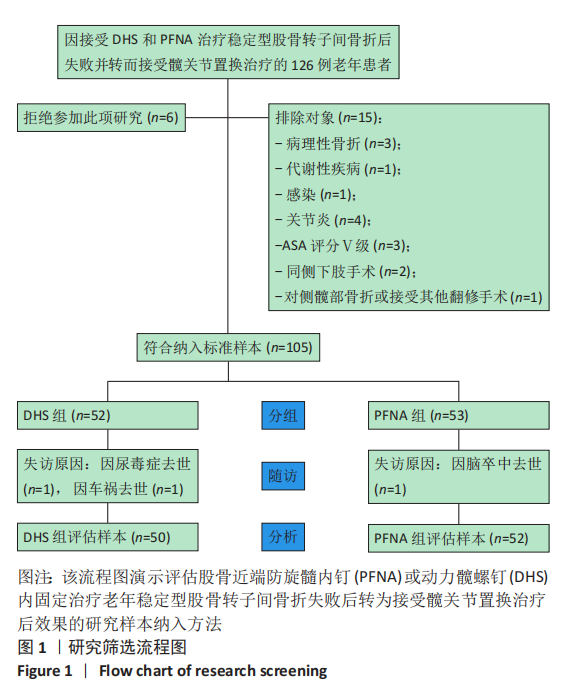
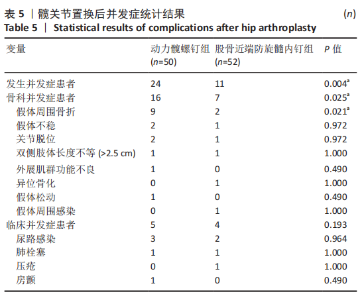
2.5 髋关节置换后各组患者并发症发生情况 符合纳入标准的患者均获得满意的随访,平均随访时间为45个月(39-52个月)。两组均未发生术中骨折及术中神经血管损伤,所有患者术后均立即接受双髋关节正位DR检查以评估手术质量,术后第2周所有患者均顺利出院。采用骨水泥型假体和非骨水泥型假体两组之间假体周围骨折发生率差异无显著性意义 (P > 0.05)。 动力髋螺钉组中约1/3患者(32.0%;16/50)在截止末次随访时出现了骨科并发症,其中包括术后假体周围骨折9例、假体不稳2例、关节脱位2例、双侧肢体长度不等(> 2.5 cm) 1例、外展肌群功能不良1例、假体松动1例;股骨近端防旋髓内钉组的发生率为13.7%(7/52),其中包括术后假体周围骨折2例、假体不稳1例、关节脱位1例、双侧肢体长度不等(> 2.5 cm)1例、异位骨化1例、假体周围感染1例。两组骨科并发症发生率的差异有显著性意义(P=0.025)。动力髋螺钉组发生9例假体周围骨折(18.0%;9/50),股骨近端防旋髓内钉组发生2例假体周围骨折(3.8%;2/52),两组假体周围骨折的发生率比较差异有显著性意义(P=0.021),见表5。"
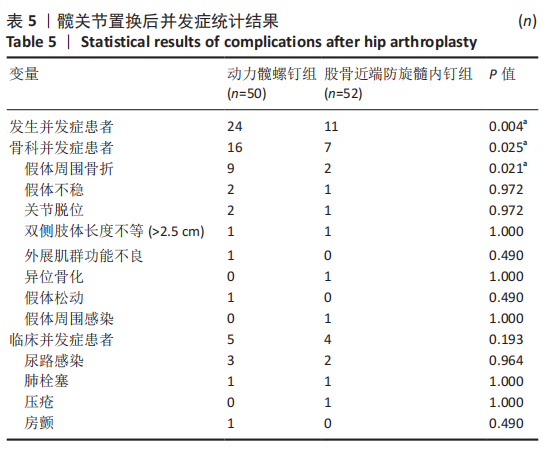
| [1] CHANG SM, HOU ZY, HU SJ, et al. Intertrochanteric femur fracture treatment in asia: what we know and what the world can learn. Orthop Clin North Am. 2020; 51(2):189-205. [2] 李振鹏,邹延澄,陈泽锋,等.老年不稳定股骨转子间骨折不同内固定手术疗效比较[J].中国骨与关节损伤杂志,2013,28(12):1137-1139. [3] 郑勇,史法见,赵晓龙,等.PFNA与DHS+空心钉内固定治疗老年股骨转子间骨折的疗效观察[J].组织工程与重建外科杂志,2019,15(5):345-348. [4] 王炎,汪海滨,史法见,等.PFNA和DHS固定治疗股骨转子间骨折的比较[J].中国矫形外科杂志,2019,27(24):2223-2227. [5] SHARMA A, SETHI A, SHARMA S. Treatment of stable intertrochanteric fractures of the femur with proximal femoral nail versus dynamic hip screw: a comparative study. Rev Bras Ortop. 2017;53(4):477-481. [6] PUI CM, BOSTROM MP, WESTRICH GH, et al. Increased complication rate following conversion total hip arthroplasty after cephalomedullary fixation for intertrochanteric hip fractures: a multi-center study. J Arthroplasty. 2013;(8 Suppl):45-47. [7] O’MALLEY MJ, KANG KK, AZER E, et al. Wedge effect following intramedullary hip screw fixation of intertrochanteric proximal femur fracture. Arch Orthop Trauma Surg. 2015;135(10):1343-1347. [8] MIN BW, LEE KJ, OH JK, et al. The treatment strategies for failed fixation of intertrochanteric fractures. Injury. 2019;50(7):1339-1346. [9] LIU L, SUN Y, WANG L, et al. Total hip arthroplasty for intertrochanteric fracture fixation failure. Eur J Med Res. 2019;24(1):39. [10] TAHERIAZAM A, SAEIDINIA A. Salvage of failed dynamic hip screw fixation of intertrochanteric fractures. Orthop Res Rev. 2019;11:93-98. [11] PARKER MJ. Sliding hip screw versus intramedullary nail for trochanteric hip fractures; a randomised trial of 1000 patients with presentation of results related to fracture stability. Injury. 2017;48(12):2762-2767. [12] SPINNICKIE A, GOODMAN SB. Dissociation of the femoral head and trunion after constrained conversion total hip arthroplasty for poliomyelitis. J Arthroplasty. 2007;22(4):634-637. [13] BERCIK MJ, MILLER AG, MUFFLY M, et al. Conversion total hip arthroplasty: a reason not to use cephalomedullary nails. J Arthroplasty. 2012;27(8 Suppl):117-121. [14] HARRIS WH. Traumatic arthritis of the hip after dislocation and acetabular fractures: treatment by mold arthroplasty. An end-result study using a new method of result evaluation. J Bone Joint Surg Am. 1969;51(4):737-55. [15] 仇赛,季晓娟,汤伯仁,等.PFNA与DHS内固定治疗股骨转子间骨折的比较[J].中国矫形外科杂志,2018,26(16):1468-1471. [16] STAMBOUGH JB, NUNLEY RM, CURRY MC, et al. Rapid recovery protocols for primary total hip arthroplasty can safely reduce length of stay without increasing readmissions. J Arthroplasty. 2015;30(4):521-526. [17] ZHA GC, CHEN ZL, QI XB, et al. Treatment of pertrochanteric fractures with a proximal femur locking compression plate. Injury. 2011;42(11):1294-1299. [18] LIU L, SUN Y, WANG L, et al. Total hip arthroplasty for intertrochanteric fracture fixation failure. Eur J Med Res. 2019;24(1):39. [19] CHEN DW, LIN CL, HU CC, et al. Biomechanical consideration of total hip arthroplasty following failed fixation of femoral intertrochanteric fractures-a finite element analysis. Med Eng Phys. 2013;35(5):569-575. [20] HAO Z, WANG X, ZHANG X. Comparing surgical interventions for intertrochanteric hip fracture by blood loss and operation time: a network meta-analysis. J Orthop Surg Res. 2018;13(1):157. [21] TANZER M, GRAVES SE, PENG A, et al. Is cemented or cementless femoral stem fixation more durable in patients older than 75 years of age? A Comparison of the Best-performing Stems. Clin Orthop Relat Res. 2018;476(7):1428-1437. [22] SIERRA RJ, TIMPERLEY JA, GIE GA. Contemporary cementing technique and mortality during and after Exeter total hip arthroplasty. J Arthroplasty. 2009;24(3):325-332. [23] MOSKAL JT, CAPPS SG, SCANELLI JA. Still no single gold standard for using cementless femoral stems routinely in total hip arthroplasty. Arthroplast Today. 2016;2(4): 211-218. [24] YU W, HAN X, CHEN W, et al. Conversion from a failed proximal femoral nail anti-rotation to a cemented or uncemented total hip arthroplasty device: a retrospective review of 198 hips with previous intertrochanteric femur fractures. BMC Musculoskelet Disord. 2020;21(1):791. [25] SHI X, ZHOU Z, YANG J, et al. Total hip arthroplasty using non-modular cementless long-stem distal fixation for salvage of failed internal fixation of intertrochanteric fracture. J Arthroplasty. 2015;30(11):1999-2003. [26] DIWANJI SR, KIM SK, SEON JK, et al. Clinical results of conversion total hip arthroplasty after failed bipolar hemiarthroplasty. J Arthroplasty. 2008;23(7):1009-1015. [27] 郑利钦,陈心敏,张彪,等.股骨转子间骨折股骨近端防旋髓内钉内固定切割失效的有限元仿真[J].中国组织工程研究,2019,23(36):5794-5799. [28] 黄培镇,陈心敏,郑利钦,等.骨质疏松影响股骨近端防旋髓内钉治疗股骨转子间骨折的有限元仿真[J].中国组织工程研究,2020,24(24):3808-3814. [29] BRAND S, BAUER M, PETRI M, et al. Impact of intraprosthetic drilling on the strength of the femoral stem in periprosthetic fractures: a finite element investigation. Proc Inst Mech Eng H. 2016;230(7):675-681. [30] LIZAUR-UTRILLA A, MIRALLES-MUÑOZ FA, RUIZ-LOZANO M, et al. Outcomes of Total Hip Arthroplasty for Healed Intertrochanteric Hip Fractures. A Matched Retrospective Cohort Study. J Arthroplasty. 2020;35(10):2926-2930. [31] LEE KH, LEE DH, NOH JH, et al. Is rigid fixation of the greater trochanter necessary for arthroplasty of intertrochanteric fractures? Orthop Traumatol Surg Res. 2019; 105(1):41-45. [32] Ju JB, Zhang PX, Jiang BG. Hip replacement as alternative to intramedullary nail in elderly patients with unstable intertrochanteric fracture: a systematic review and meta-analysis. Orthop Surg. 2019;11(5):745-754. [33] 覃勇志,周凯,王端,等.股骨转子间骨折内固定失败后人工全髋关节置换治疗的安全性及有效性分析[J].中国修复重建外科杂志,2019,33(2):160-165. (责任编辑:WJ,ZN,ZH) |
| [1] | Jiang Yong, Luo Yi, Ding Yongli, Zhou Yong, Min Li, Tang Fan, Zhang Wenli, Duan Hong, Tu Chongqi. Von Mises stress on the influence of pelvic stability by precise sacral resection and clinical validation [J]. Chinese Journal of Tissue Engineering Research, 2021, 25(9): 1318-1323. |
| [2] | Zhang Yu, Tian Shaoqi, Zeng Guobo, Hu Chuan. Risk factors for myocardial infarction following primary total joint arthroplasty [J]. Chinese Journal of Tissue Engineering Research, 2021, 25(9): 1340-1345. |
| [3] | Li Dadi, Zhu Liang, Zheng Li, Zhao Fengchao. Correlation of total knee arthroplasty efficacy with satisfaction and personality characteristics [J]. Chinese Journal of Tissue Engineering Research, 2021, 25(9): 1346-1350. |
| [4] | Wei Wei, Li Jian, Huang Linhai, Lan Mindong, Lu Xianwei, Huang Shaodong. Factors affecting fall fear in the first movement of elderly patients after total knee or hip arthroplasty [J]. Chinese Journal of Tissue Engineering Research, 2021, 25(9): 1351-1355. |
| [5] | Wang Jinjun, Deng Zengfa, Liu Kang, He Zhiyong, Yu Xinping, Liang Jianji, Li Chen, Guo Zhouyang. Hemostatic effect and safety of intravenous drip of tranexamic acid combined with topical application of cocktail containing tranexamic acid in total knee arthroplasty [J]. Chinese Journal of Tissue Engineering Research, 2021, 25(9): 1356-1361. |
| [6] | Peng Zhihao, Feng Zongquan, Zou Yonggen, Niu Guoqing, Wu Feng. Relationship of lower limb force line and the progression of lateral compartment arthritis after unicompartmental knee arthroplasty with mobile bearing [J]. Chinese Journal of Tissue Engineering Research, 2021, 25(9): 1368-1374. |
| [7] | Zhang Chong, Liu Zhiang, Yao Shuaihui, Gao Junsheng, Jiang Yan, Zhang Lu. Safety and effectiveness of topical application of tranexamic acid to reduce drainage of elderly femoral neck fractures after total hip arthroplasty [J]. Chinese Journal of Tissue Engineering Research, 2021, 25(9): 1381-1386. |
| [8] | Zhang Shangpu, Ju Xiaodong, Song Hengyi, Dong Zhi, Wang Chen, Sun Guodong. Arthroscopic suture bridge technique with suture anchor in the treatment of acromioclavicular dislocation [J]. Chinese Journal of Tissue Engineering Research, 2021, 25(9): 1417-1422. |
| [9] | Yuan Jiawei, Zhang Haitao, Jie Ke, Cao Houran, Zeng Yirong. Underlying targets and mechanism of Taohong Siwu Decoction in prosthetic joint infection on network pharmacology [J]. Chinese Journal of Tissue Engineering Research, 2021, 25(9): 1428-1433. |
| [10] | Chen Junming, Yue Chen, He Peilin, Zhang Juntao, Sun Moyuan, Liu Youwen. Hip arthroplasty versus proximal femoral nail antirotation for intertrochanteric fractures in older adults: a meta-analysis [J]. Chinese Journal of Tissue Engineering Research, 2021, 25(9): 1452-1457. |
| [11] | Huang Dengcheng, Wang Zhike, Cao Xuewei. Comparison of the short-term efficacy of extracorporeal shock wave therapy for middle-aged and elderly knee osteoarthritis: a meta-analysis [J]. Chinese Journal of Tissue Engineering Research, 2021, 25(9): 1471-1476. |
| [12] | Liu Yafei, Wang Yalin, Zuo Yanping, Sun Qi, Wei Jing, Zhao Lixia. Structural changes of the temporomandibular joint in adolescents with skeletal Class III malocclusions after maxillary protraction: an X-ray measurement analysis [J]. Chinese Journal of Tissue Engineering Research, 2021, 25(8): 1154-1159. |
| [13] | Wu Xun, Meng Juanhong, Zhang Jianyun, Wang Liang. Concentrated growth factors in the repair of a full-thickness condylar cartilage defect in a rabbit [J]. Chinese Journal of Tissue Engineering Research, 2021, 25(8): 1166-1171. |
| [14] | Geng Qiudong, Ge Haiya, Wang Heming, Li Nan. Role and mechanism of Guilu Erxianjiao in treatment of osteoarthritis based on network pharmacology [J]. Chinese Journal of Tissue Engineering Research, 2021, 25(8): 1229-1236. |
| [15] | Zhao Zhongyi, Li Yongzhen, Chen Feng, Ji Aiyu. Comparison of total knee arthroplasty and unicompartmental knee arthroplasty in treatment of traumatic osteoarthritis [J]. Chinese Journal of Tissue Engineering Research, 2021, 25(6): 854-859. |
| Viewed | ||||||
|
Full text |
|
|||||
|
Abstract |
|
|||||
